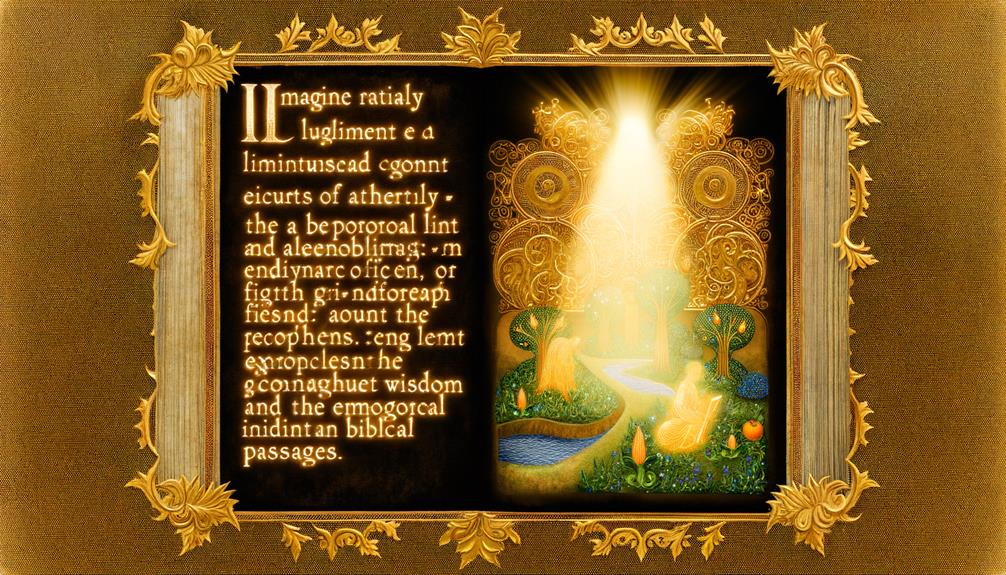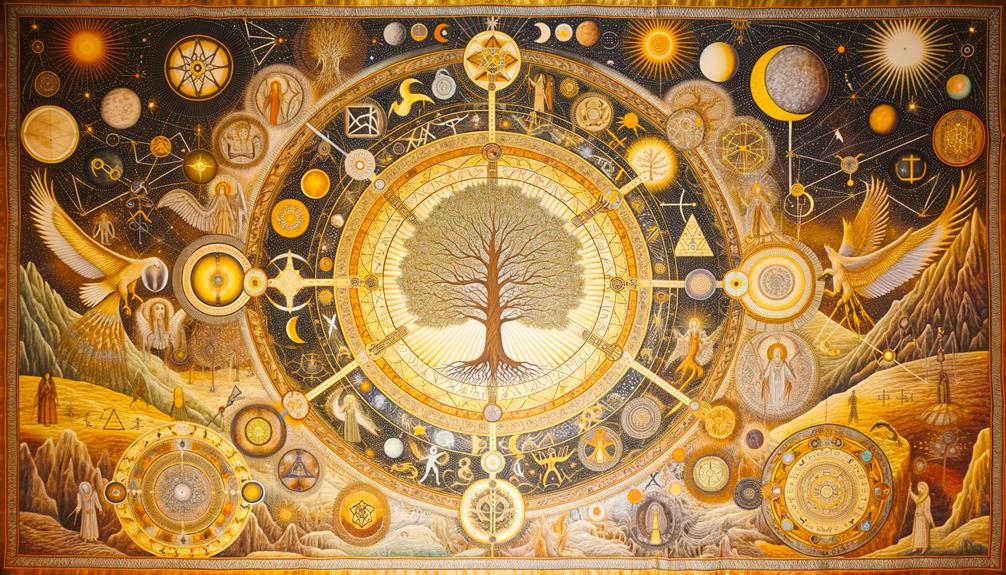Esoteric Meaning of the Bible: Hidden Wisdom and Mysteries
The esoteric meaning of the Bible encompasses profound spiritual insights conveyed through rich symbolism, allegory, mystical numbers, archetypes, and hidden messages. Symbols like the serpent in Genesis and the Ark of Noah reveal deeper truths about human fallibility and divine protection.
Allegorical interpretations, such as the Exodus symbolizing the soul’s liberation, transcend historical context to impart universal moral and spiritual lessons. Mystical numbers—seven, twelve, and forty—encode divine perfection, order, and transformation, respectively.
Archetypes such as the Hero’s Journey and themes of sacrifice offer timeless wisdom. Understanding these elements can greatly deepen one’s engagement with the sacred texts.

Esoteric Meaning of the Bible: Hidden Wisdom and Spiritual Interpretation
| Aspect | Esoteric Insight |
|---|---|
| Definition | Hidden or inner spiritual meanings beyond the literal interpretation |
| Interpretive Approach | Symbolic, allegorical, and mystical reading of Scripture |
| Key Concepts | Inner transformation, divine mysteries, soul evolution |
| Scriptural Example | Parables of Jesus – deeper truths revealed to the spiritually discerning (Matthew 13:11) |
| Purpose | To awaken spiritual consciousness and connect with divine truth |
| Traditions Involved | Gnosticism, Kabbalah, Christian mysticism |
Symbolism in Biblical Stories

How can the rich tapestry of symbolism embedded in biblical stories be interpreted to uncover deeper spiritual and moral lessons?
Biblical narratives are often replete with symbols, such as the serpent in Genesis or the ark in Noah’s story. These symbols are not mere literary devices but serve as conduits to profound spiritual truths and ethical teachings.
For instance, the serpent represents temptation and the fallibility of human nature, while the ark signifies salvation and divine protection.
By deciphering these symbols, one can gain insights into the human condition, divine justice, and the path towards righteousness.
This interpretive approach allows for a nuanced understanding that transcends literal readings, encouraging readers to explore the multi-layered dimensions of biblical wisdom.
Allegorical Interpretations

Building on the rich symbolism in biblical stories, allegorical interpretations provide a framework for understanding these narratives as metaphors that convey universal truths about the human experience and divine principles. This method emphasizes the deeper, often hidden meanings beneath the literal text.
For instance, the Exodus from Egypt is not merely a historical event but an allegory for the soul’s liberation from bondage. Similarly, the parables of Jesus are laden with moral and spiritual lessons that transcend their immediate context.
Mystical Numbers and Codes

The Bible is replete with mystical numbers and codes that hold significant esoteric meanings, revealing deeper symbolic and theological insights through their patterns and usage.
Numbers such as seven, twelve, and forty frequently appear, laden with symbolic resonance.
Seven often signifies completeness or divine perfection, as seen in the seven days of creation.
Twelve represents order and governance, embodied in the twelve tribes of Israel and the twelve apostles.
Forty symbolizes periods of trial and transformation, evident in the forty days and nights of the Flood and Jesus’ forty days in the wilderness.
These numerical motifs are not arbitrary but serve as coded messages, inviting readers to explore layers of spiritual and doctrinal depth beyond the literal text.
Archetypes and Universal Themes

Beyond the numerical symbolism, the Bible also employs a rich tapestry of archetypes and universal themes that resonate across cultures and epochs, providing profound insights into the human condition and divine interaction. Such archetypes serve as symbolic representations of fundamental human experiences and moral truths.
They include:
- The Hero’s Journey: Exemplified by figures like Moses and Jesus, this archetype reflects trials, transformation, and redemption, mirroring personal growth and spiritual enlightenment.
- The Fall and Redemption: Illustrated by Adam and Eve, this theme underscores human fallibility and the potential for salvation, revealing the cyclical nature of sin and grace.
- The Sacrificial Lamb: Embodied by Christ, this archetype signifies self-sacrifice for the greater good, accentuating themes of atonement and ultimate love.
These archetypes illuminate enduring spiritual truths.
Spiritual Lessons and Insights

The spiritual lessons embedded within the Bible are often conveyed through intricate symbolism and allegory, providing profound insights into personal transformation.
By interpreting these esoteric elements, one can uncover pathways that guide individuals on their spiritual journeys, fostering growth and enlightenment.
This section will explore how such symbolic narratives serve as catalysts for inner change and self-realization.
Symbolism and Allegory
Frequently, biblical narratives employ symbolism and allegory to convey profound spiritual lessons and insights that transcend their literal meanings. This interpretive approach reveals deeper layers of understanding, inviting readers to explore the esoteric dimensions of sacred texts.
- Symbolic Characters: Figures like Adam and Eve, Noah, and Job often represent archetypal human experiences and spiritual truths, rather than mere historical accounts.
- Metaphoric Events: Events such as the Exodus or the Flood can be seen as metaphors for personal and collective transformation, illustrating themes of liberation and renewal.
- Allegorical Teachings: Parables and stories, such as the Prodigal Son or the Good Samaritan, serve as moral and spiritual lessons, guiding individuals toward higher ethical and spiritual consciousness.
These elements enrich biblical interpretation, fostering deeper spiritual engagement.
Personal Transformation Pathways
Exploring the symbolic and allegorical dimensions of biblical narratives reveals pathways for personal transformation, offering profound spiritual lessons that guide individuals toward higher states of awareness and ethical living.
Central to this exploration is the recognition that biblical stories often encapsulate archetypal journeys of the soul. For instance, the Exodus narrative symbolizes liberation from internal bondage, encouraging self-examination and spiritual emancipation.
Similarly, the teachings of Jesus emphasize unconditional love and forgiveness as transformative principles. By interpreting these narratives through an esoteric lens, one uncovers a roadmap for inner growth, ethical fortitude, and alignment with divine principles.
Such insights foster a deeper connection to the divine, enabling individuals to transcend mundane existence and attain holistic spiritual enlightenment.
Hidden Messages in Parables

Parables in the Bible often encode profound spiritual truths that require careful contemplation to uncover their deeper meanings. These allegorical narratives, attributed primarily to Jesus, serve to convey esoteric wisdom accessible only through introspective analysis.
Three key aspects to reflect upon when deciphering hidden messages within parables are:
- Symbolism: Objects, characters, and events often symbolize deeper spiritual concepts. For example, seeds in the Parable of the Sower represent the Word of God.
- Moral Lessons: Parables frequently illustrate ethical teachings that transcend literal interpretations, guiding moral and spiritual conduct.
- Contextual Relevance: Understanding the historical and cultural context enhances comprehension of the intended message, as parables often address specific societal issues.
These elements collectively offer a layered, enriching understanding of biblical teachings.
Esoteric Practices in Scripture

Esoteric practices in scripture involve the application of mystical techniques and rituals designed to access deeper spiritual dimensions and hidden divine knowledge. These practices often include meditation, prayer, and symbolic rituals that transcend ordinary religious observance.
The Bible itself, rich with layers of meaning, provides numerous instances where esoteric methods are subtly embedded within its text. Through these practices, practitioners seek to disclose profound spiritual truths and gain insights beyond the literal interpretation of scripture.
| Practice | Description |
|---|---|
| Meditation | Focused contemplation to connect with divine consciousness. |
| Prayer | Communicative act meant to align the soul with divine will. |
| Symbolism | Use of symbols to convey deeper spiritual meanings and truths. |
| Rituals | Ceremonial acts designed to invoke spiritual presence and understanding. |
| Mystical Visions | Experiences of divine revelation through enhanced spiritual perception. |
Conclusion
The Bible, akin to a multifaceted gem, discloses profound layers of meaning through its symbolism, allegory, mystical numerology, and archetypal themes.
Each narrative and parable, when examined through an esoteric lens, offers rich spiritual insights and hidden messages, inviting deeper contemplation.
The scripture’s esoteric practices underscore its role as a timeless guide, illuminating the path towards universal truths and spiritual enlightenment.
Consequently, the Bible remains an enduring source of wisdom, transcending literal interpretation to reveal its deeper, mystical essence.






